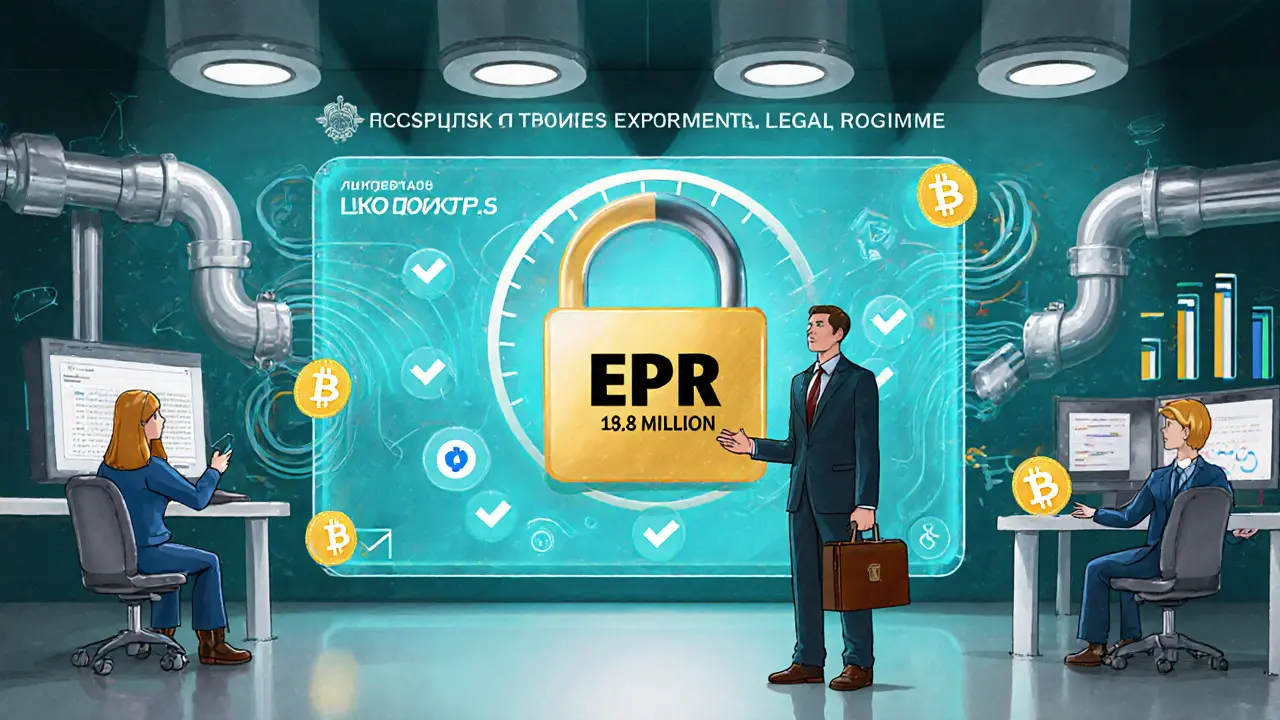 Aug, 1 2025
Aug, 1 2025
Russian cryptocurrency regulation is a layered legal framework that treats digital assets as property, bans their use for domestic payments, and permits limited cross‑border Bitcoin transactions under strict conditions. Since 2021 the ban has reshaped how Russian users, businesses, and foreign partners handle crypto.
Key Takeaways
- The 2020 Federal Law No.114‑FZ legalized crypto ownership but forbade its use for everyday purchases inside Russia.
- Law No.382‑FZ (summer2024) opened a narrow gateway for Bitcoin payments in international trade, but only through the Experimental Legal Regime (EPR).
- Crypto is taxed as property at 13% capital gains, and miners must register with Roskomnadzor.
- Fines for domestic payment violations start at 100,000rubles for individuals and rise to 1millionrubles for firms.
- Compliance costs are high - businesses spend over 2millionrubles and 200+ staff hours to meet EPR requirements.
How the Domestic Ban Works
Federal Law No.114‑FZ, signed in July2020, defined digital assets as “property” and explicitly prohibited their use as payment for goods or services on Russian soil. The prohibition became effective on 1January2021. Violations trigger administrative fines and mandatory confiscation of the crypto involved.
Enforcement relies on the Bank of Russia’s AML recommendations (Feb2025) which flag peer‑to‑peer (P2P) transfers over 600,000rubles. Financial institutions must report these transactions, and the State Duma’s draft fine bill (July2025) will raise penalties in 2026.
International Bitcoin Use: The 2024 Opening
In response to Western sanctions, Law No.382‑FZ (summer2024) allowed crypto payments-but only for cross‑border trade and only within the Experimental Legal Regime. Participants must:
- Register with the Central Bank’s EPR portal.
- Deploy a monitoring system handling ≥1,000tps with 99.9% uptime.
- Demonstrate “especially qualified investor” status (assets>100millionrubles or annual income>50millionrubles).
The regime is experimental, slated for three years (2024‑2027), and aims to channel crypto‑facilitated exports while keeping domestic usage off‑limits.

Taxation and Mining Rules
From 1January2025 the Tax Code treats crypto as property: capital gains are taxed at 13%, and quarterly reporting is mandatory. Mining firms must register with Roskomnadzor, stay under a 150MW energy cap, and keep detailed logs for seven years.
Foreign exchanges wishing to operate in Russia must set up a Russian legal entity, hold 100millionrubles in capital, and link all crypto‑fiat conversions to a Russian bank account with full KYC.
Comparison: Domestic Ban vs International Allowance
| Aspect | Domestic Use | International Use (EPR) |
|---|---|---|
| Legal status | Property - payment prohibited | Property - payment allowed for trade |
| Who can transact | Anyone owning crypto | Only “especially qualified investors” or registered entities |
| Reporting threshold | 600,000rubles (AML) | All EPR transactions logged in real‑time |
| Tax rate | 13% capital gains | 13% capital gains (same) |
| Penalty for violation | 100,000‑200,000rubles (individual) / 700,000‑1,000,000rubles (entity) | Fines same as domestic + possible license revocation |
| Typical users | Retail crypto holders, miners | Large exporters, ultra‑high‑net‑worth investors |
Compliance Costs and Practical Challenges
Businesses that want to join the EPR face a steep onboarding process: 14 compliance modules, API integration with the CryptoTrack system, and a minimum 99.95% transaction‑monitoring accuracy. According to BitLegal, the average cost to achieve full compliance is about 1.8millionrubles ($22,500) and 220 staff‑hours.
Local firms report long approval cycles - an IT exporter described an eight‑week, 17‑document registration that forced it to abandon crypto payments altogether.
For individuals, the high investor threshold (100millionrubles) excludes roughly 87% of the estimated 18million Russian crypto owners, pushing many to offshore platforms that add 3‑5business days and 2.5% extra fees, as noted on Reddit’s r/CryptoRussia.

International Perspective: How Russia Stands Apart
Unlike ElSalvador, which made Bitcoin legal tender, or China, which banned all crypto activity, Russia occupies a middle ground: ownership is allowed, but payment use is split. Compared to India’s 30% capital‑gains tax and modest investor qualification, Russia’s 100million‑ruble threshold is among the toughest worldwide, even tougher than Japan’s 50million‑yen rule.
The EU’s MiCA framework permits crypto payments with consumer safeguards, while Russia continues to block domestic usage and only relaxes cross‑border rules for a tiny elite.
Future Outlook and Upcoming Tweaks
Legislators plan to extend the domestic payment ban to stablecoins by 2027, citing systemic risk after the TerraUSD crash. The Central Bank’s September2025 roadmap foresees expanding AML monitoring to non‑custodial wallets by Q22026 and adding biometric verification for transactions over 500,000rubles by Q42026.
Projections from the Central Bank suggest crypto‑facilitated exports could hit $8.5billion in 2026, a 165% jump from 2025, while domestic merchant acceptance remains below 3%.
Analysts warn that if the domestic market stays starved, underground activity could surge, undermining the very AML goals the regime seeks to protect.
Frequently Asked Questions
Can I use Bitcoin to buy a coffee in Moscow?
No. The domestic payment ban covers all goods and services purchased inside Russia, regardless of the amount.
What qualifies as an “especially qualified investor”?
You need either at least 100millionrubles (≈$1.2million) in financial assets or an annual income above 50millionrubles (≈$580,000). These thresholds apply to individuals and legal entities alike.
How are crypto gains taxed in Russia?
Gains are taxed at a flat 13% rate. You must report them quarterly to the Federal Tax Service and keep detailed transaction logs for seven years.
Do I need a Russian bank account to trade crypto?
Yes. All crypto‑to‑fiat conversions must be linked to a Russian bank account that complies with full KYC verification.
What are the penalties for violating the payment ban?
Individuals face fines of 100,000‑200,000rubles; legal entities can be fined 700,000‑1,000,000rubles, plus confiscation of the crypto used in the illegal payment.
Understanding the crypto payment ban Russia helps anyone navigating the tangled web of rules, taxes, and compliance costs. Whether you’re a trader, a miner, or a business looking to export, knowing where the line is drawn-and how to stay on the right side of it-can save you money, time, and legal trouble.
David Moss
August 1, 2025 AT 00:21We can't ignore the fact that Russia's crypto charade is just another tool of the global elite, watching every transaction, ready to pounce on any deviation from the script-anyone who thinks this is benign is simply naive. The domestic ban feels like a covert method to funnel wealth into state‑approved channels, while the international loophole is just a façade for sanctioned entities to keep their doors open. If you look past the legalese, it's a clear signal that power structures will always find ways to control emerging technology.
Pierce O'Donnell
August 1, 2025 AT 01:53The whole thing feels like a bureaucratic nightmare built to stifle innovation.
Vinoth Raja
August 1, 2025 AT 03:33From a systems‑theory perspective, the bifurcation of crypto usage creates a dual‑layered risk surface that can be modeled with stochastic processes. By treating digital assets as property, the legislation imposes a compliance overhead that scales quadratically with transaction volume, especially for P2P flows exceeding the 600k‑ruble threshold. Meanwhile, the Experimental Legal Regime demands a monitoring stack capable of ≥1,000 tps and 99.9 % uptime, which is non‑trivial for mid‑size exporters. The capital‑gatekeeper requirement (≥100 M rubles) effectively filters out all but the top‑tier investors, turning the regime into an elite club. Taxation at a flat 13 % aligns Russia with several G‑20 jurisdictions, but the seven‑year log retention introduces a data‑extraction vector for future audits. Mining firms are now forced to stay under a 150 MW cap, which translates to a massive CAPEX shift toward renewable sources or grid‑friendly hardware. Finally, the AML escalation slated for 2026 will likely integrate non‑custodial wallet analytics, further tightening the noose around informal networks.
Cecilia Cecilia
August 1, 2025 AT 03:35I see the practical challenges you're outlining, especially the cost of maintaining that level of uptime. The compliance burden does seem disproportionate for anything short of a multinational exporter.
Miguel Terán
August 1, 2025 AT 05:13The Russian approach kinda mirrors a high‑stakes chess game where the king stays put and the pawns get shuffled around the board. On one side you have a domestic ban that looks like it's protecting citizens from volatility, but in reality it pushes everyday traders toward offshore mixers and shadow exchanges. On the other side, the shiny International Bitcoin gateway is only open for those who can flash a 100 million‑ruble balance badge-basically a VIP lounge for the ultra‑wealthy. Meanwhile, the compliance modules feel like a bureaucratic maze: fourteen steps, dozens of documents, and a waiting period that would make a snail blush. For a typical startup, those hurdles translate into lost market share and a decision to abandon crypto altogether. The net effect? A fragmented ecosystem where only the well‑funded survive, and the rest either go underground or give up.
Shivani Chauhan
August 1, 2025 AT 05:15Your description captures the essence of the regulatory paradox quite well. It is evident that the thresholds create a barrier that excludes the majority of domestic participants. A more inclusive framework could mitigate the drift toward illicit channels.
Schuyler Whetstone
August 1, 2025 AT 06:53Honestly this whole crypto ban is just another excuse for the Kremlin to keep its grip on the financial system, and the so‑called “experimental regime” is nothing but a backdoor for the elite. Who cares about 13% tax when the state can just seize your coins if you step out of line. The fines are ridiculous but they’ll keep most people scared into compliance.
Jason Zila
August 1, 2025 AT 06:55While the sentiment is understandable, the reality is that the regime does introduce some transparency for cross‑border trade that could benefit legitimate businesses. Ignoring that nuance only fuels paranoia.
lida norman
August 1, 2025 AT 08:33It's sad to see such restrictions, but hope things improve 😊
Jessica Cadis
August 1, 2025 AT 08:35Optimism is nice, yet it shouldn't blind us to the concrete obstacles that small entrepreneurs face under these rules.
Katharine Sipio
August 1, 2025 AT 10:46Understanding the Russian crypto landscape requires patience and a willingness to dissect layers of legislation that often seem contradictory at first glance. First, the designation of digital assets as property was a strategic move to fit crypto into existing tax structures without granting it full financial legitimacy. Second, the domestic ban on using crypto for payments effectively creates a black market where everyday users must either abandon digital currencies or resort to offshore platforms that operate beyond the reach of Russian authorities. Third, the Experimental Legal Regime (EPR) for international transactions offers a narrow corridor for cross‑border trade, but the entry requirements are so stringent that only a tiny fraction of investors qualify. Fourth, the compliance costs, including a minimum of 1.8 million rubles and hundreds of staff hours, act as a de‑facto barrier for small and medium‑sized enterprises. Fifth, the tax treatment at a flat 13 % aligns with other jurisdictions, yet the mandatory seven‑year transaction log creates a data‑retention burden that many firms are ill‑prepared to handle. Sixth, mining operations are now capped at 150 MW, pushing smaller miners out of the market and concentrating hash power among a few large players. Seventh, the upcoming AML expansion to non‑custodial wallets will likely introduce advanced analytics that could further erode privacy for legitimate users. Eighth, the penalties for violating the payment ban, ranging from 100 000 to 1 million rubles, serve as a deterrent but also incentivize the growth of underground networks that operate under the radar. Ninth, the comparison with other jurisdictions, such as El Salvador's adoption of Bitcoin as legal tender, highlights how Russia's middle‑ground approach may ultimately disadvantage its domestic crypto ecosystem. Tenth, the EU's MiCA framework, which promotes consumer safeguards while allowing crypto payments, showcases an alternative regulatory path that balances innovation and protection. Eleventh, the projected growth of crypto‑facilitated exports to $8.5 billion by 2026 suggests that the international gateway does have economic potential if properly managed. Twelfth, however, the low domestic merchant acceptance rate-below three percent-indicates that the ban is effectively suppressing internal market development. Thirteenth, the risk of increased underground activity looms large, potentially undermining AML goals and creating new enforcement challenges. Fourteenth, the looming extension of the ban to stablecoins by 2027 could further restrict access to crypto‑based financial services for ordinary citizens. Finally, policymakers must weigh the short‑term gains of control against the long‑term costs of stifling financial innovation and driving users toward less regulated, riskier alternatives.
Shikhar Shukla
August 1, 2025 AT 10:48The analysis is thorough, but it underestimates the strategic intent behind the thresholds, which are designed to safeguard the national economy from capital flight. A more critical assessment of the geopolitical motivations would provide a fuller picture.
Deepak Kumar
August 1, 2025 AT 10:50Indeed, the regulatory environment is challenging, yet it also presents an opportunity for firms that can master the compliance landscape to gain a competitive edge. By investing in robust monitoring infrastructure now, businesses position themselves for future growth as the regime matures. Moreover, collaborative efforts across the industry can help lower costs and share best practices. Persistence and adaptability will be key.
Matthew Theuma
August 1, 2025 AT 12:43Just looking at the numbers, you can see the tension between control and growth – it’s a classic trade‑off that many governments face 😅. The crypto space keeps evolving, and so do the rules. Folks just need to stay informed and flexible.
Carolyn Pritchett
August 1, 2025 AT 12:45While your tone is light, the underlying issue is that these policies could push legitimate users into risky shadow markets, and that’s a serious concern.